Planning worship?
Check out our sister site, ZeteoSearch.org,
for 20+ additional resources related to your search.
- |
User Links
Person Results
Communauté de Taizé
Person Name: Community of Taizé Author of "The Lord Is My Light" in Psalms for All Seasons
Communauté de Taizé
Jacques Berthier

1923 - 1994 Composer of "THE LORD IS MY LIGHT" in Glory to God Jacques Berthier (b. Auxerre, Burgundy, June 27, 1923; d. June 27, 1994) A son of musical parents, Berthier studied music at the Ecole Cesar Franck in Paris. From 1961 until his death he served as organist at St. Ignace Church, Paris. Although his published works include numerous compositions for organ, voice, and instruments, Berthier is best known as the composer of service music for the Taizé community near Cluny, Burgundy. Influenced by the French liturgist and church musician Joseph Gelineau, Berthier began writing songs for equal voices in 1955 for the services of the then nascent community of twenty brothers at Taizé. As the Taizé community grew, Berthier continued to compose most of the mini-hymns, canons, and various associated instrumental arrangements, which are now universally known as the Taizé repertoire. In the past two decades this repertoire has become widely used in North American church music in both Roman Catholic and Protestant traditions.
Bert Polman
Jacques Berthier
David Haas
b. 1957 Person Name: David Haas, b. 1957 Composer of "MY LIGHT AND MY SALVATION" in Lift Up Your Hearts
David Haas
Michael Joncas
b. 1951 Person Name: Michael Joncas, b. 1951 Author of "The Lord Is Near" in Gather Comprehensive
Michael Joncas
Christopher Walker
b. 1947 Person Name: Christopher Walker Author (refrain) of "The LORD Is My Light" in Christian Worship
Christopher Walker
James Turle
1802 - 1882 Person Name: J. Turle Composer of "[The Lord is my light and my salvation, whom shall I fear]" in The Methodist Hymn-Book with Tunes TURLE, JAMES (1802–1882), organist and composer, son of James Turle, an amateur 'cello-player, was born at Taunton, Somerset, on 5 March 1802. From July 1810 to December 1813 he was a chorister at Wells Cathedral under Dodd Perkins, the organist. At the age of eleven he came to London, and was articled to John Jeremiah Goss, but he was largely self-taught. He had an excellent voice and frequently sang in public. John Goss [q. v.], his master's nephew, was his fellow student, and thus the future organists of St. Paul's Cathedral and Westminster Abbey were pupils together. Turle was organist of Christ Church, Surrey (Blackfriars Road), 1819–1829, and of St. James's, Bermondsey, 1829–31. His connection with Westminster Abbey began in 1817, when he was only fifteen. He was at first pupil of and assistant to G. E. Williams, and subsequently deputy to Thomas Greatorex [q. v.], Williams's successor as organist of the abbey. On the death of Greatorex on 18 July 1831, Turle was appointed organist and master of the choristers, an office which he held for a period of fifty-one years. Turle played at several of the great musical festivals, e.g. Birmingham and Norwich, under Mendelssohn and Spohr, but all his interests were centred in Westminster Abbey. His playing at the Handel festival in 1834 attracted special attention. At his own request the dean and chapter relieved him of the active duties of his post on 26 Sept. 1875, when his service in D was sung, and Dr. (now Professor Sir John Frederick) Bridge, the present organist, became permanent deputy-organist. Turle continued to hold the titular appointment till his death, which took place at his house in the Cloisters on 28 June 1882. The dean offered a burial-place within the precincts of the abbey, but he was interred by his own express wish beside his wife in Norwood cemetery. A memorial window, in which are portraits of Turle and his wife, was placed in the north aisle of the abbey by one of his sons, and a memorial tablet has been affixed to the wall of the west cloister. Turle married, in 1823, Mary, daughter of Andrew Honey, of the exchequer office. She died in 1869, leaving nine children. Henry Frederic Turle [q. v.] was his fourth son. His younger brother Robert was for many years organist of Armagh Cathedral.
Turle was an able organist of the old school, which treated the organ as essentially a legato instrument. He favoured full ‘rolling’ chords, which had a remarkable effect on the vast reverberating space of the abbey. He had a large hand, and his ‘peculiar grip’ of the instrument was a noticeable feature of his playing. His accompaniments were largely traditional of all that was best in his distinguished predecessors, and he greatly excelled in his extemporaneous introductions to the anthems. Like Goss, he possessed great facility in reading from a ‘figured bass.’ Of the many choristers who passed through his hands, one of the most distinguished is Mr. Edward Lloyd, the eminent tenor singer.
His compositions include services, anthems, chants, and hymn-tunes. Several glees remain in manuscript. In conjunction with Professor Edward Taylor [q. v.] he edited ‘The People's Music Book’ (1844), and ‘Psalms and Hymns’ (S. P. C. K. 1862). His hymn-tunes were collected by his daughter, Miss S. A. Turle, and published in one volume (1885). One of these, ‘Westminster,’ formerly named ‘Birmingham,’ has become widely known, and is very characteristic of its composer.
--en.wikisource.org/
James Turle
Edward F. Rimbault
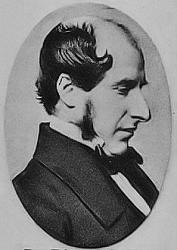
1816 - 1876 Person Name: E. F. Rimbault Composer of "[The Lord is my light and my salvation, whom shall I fear]" in The Methodist Hymn-Book with Tunes Edward Francis Rimbault PhD LLD United Kingdom 1816-1876. Born in Soho, London, England, son of an organist and composer of French descent, he was taught music by his father., Samuel Wesley, and Wiliam Crotch. At age 16 he became organist of the Swiss Church in Soho. He later became organist at various churches, including St Peter’s, Vere Street, and St John’s Wood Presbyterian Church. He edited many collections of music, journals, and publications of music, and arranged music compositions. In addition to editing or arranging contemporary operas, he had a strong interest in editing or arranging earlier English music. He studied the musical treatises in the library of Archbishop Tenison, one of the oldest public libraries in London. In 1838, At age 22 he began lecturing about the history of English music, and was in much demand due to the interest aroused. He did editorial work for the Percy Society, the Camden Society, the Motet Society, and the Handel Society. For the latter he edited the “Messiah”, “Saul”, and “Samson” He was elected a Fellow of the Society of Antiquaries, and was granted membership in the Academy of Music in Stockholm, Sweden. Gottingen University also conferred upon him a PhD. His reputation was such that he was offered a teaching position at Harvard University in the U.S., which he turned down. In 1848 he was given an honorary degree by the University of Oxford. In 1849 he published a collection of English nursery rhymes and the tunes to which they were sung. Rimbault authored 76 books, a few named here include : “Bibliotheca madrigaliana” (1847); “The pianoforte” (1860); “Early English organ builders and their works” (1865). In 1855 he co-authored “The organ- its history and construction” with John Hopkins. He did a small amount of composing as well. He wrote an operetta in 1838, and a musical drama. He also composed a large number of pianoforte scores for operas by others. He was an admirable harmonium player. Traveling to various auctions for years, he accumulated a rare collection of books. After his death his extensive collection was auctioned off in 1877, with many items going to the British Library. About 300 items were sold to an individual, and upon his death in 1888, the ‘Drexel collection’ was bequeathed to the Lenox Library (precursor of the New York Public Library). Today, the collection is part of the Music Division of the NY Public Library for the Performing Arts. He was an author, editor, arranger, composer, lithographer, translator, scribe, adapter, and bookseller. He died at London, England. No information found regarding a family.
John Perry
Edward F. Rimbault
F. A. Gore Ouseley
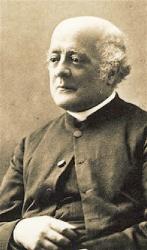
1825 - 1889 Person Name: Ouseley Composer of "[The Lord is my Light and my Salvation]" in Sunday-School Book Born: August 12, 1825, London, England.
Died: April 6, 1889, Hereford, England.
Buried: Church of St. Michael and All Angels, Tenbury Wells, Hereford and Worcester, England.
Gore-Ouseley was educated at Oxford University (BA 1846, MA 1849, DMus 1854), and was ordained in 1849. In 1855, he was appointed Oxford Professor of Music, succeeding Henry Bishop. At that time, Oxford music degrees were easy to obtain, as there were no conditions of residence. Candidates only had to submit a musical composition, (e.g., for choir or orchestra). This was then approved by the examiner, rehearsed and performed to a small, select audience at Oxford. As far as Ouseley was concerned, this only meant two or three trips to Oxford each year, usually for two or three days each time, as there was no music "taught" in the university and very little in Oxford itself at the time.
Also in 1855, Ouseley was appointed Precentor of Hereford Cathedral, a post he held for the next 30 years, before becoming a Canon there. Although theoretically in charge of the cathedral choir, Ouseley only had to be in residence at the cathedral two months each year, and he arranged these to take place during the summer vacation, when he was not required to be at his College, although such was his commitment that he did make regular visits to the cathedral, which was only 18 miles from his College at St. Michael’s.
His College of St. Michael’s, Tenbury, a "model" choir school, opened in 1856, mostly at his own expense. He founded the College and was its first Warden, which was the greater part of his work for the next 33 years.
Ouseley’s compositions covered a wide range: operas, songs, chamber music and organ pieces. His works include the following treatises:
Harmony (London: 1868)
Counterpoint (London: 1869)
Canon and Fugue (London: 1869)
Form and General Composition (London: 1875)
--www.hymntime.com/tch/
F. A. Gore Ouseley
Henry Lawes
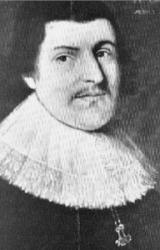
1596 - 1662 Person Name: H. Lawes Composer (from) of "[The Lord is my light and my salvation]" in The Hymnary of the United Church of Canada Born: January 5, 1596, Dinton, Wiltshire, England.
Died: October 21, 1662, London, England.
Buried: In the cloisters of Westminster Abbey, London, England.
Lawes, tutor to the daughters of the Earl of Bridgewater, is best known as a composer. He became a Gentleman of the Chapel Royal in 1626, and a member of the "King’s Musick" in 1631. He wrote over 400 vocal pieces, as well as anthems and instrumental compositions. His works include:
Choice Psalmes Put into Musick for Three Voices, 1648
Ayres and Dialogues (London: 1653)
Sources:
Frost, p. 680
Hughes, pp. 467-68
Nutter, p. 460
Stulken, p. 292
--www.hymntime.com/tch
Henry Lawes
Randall Keith DeBruyn
b. 1947 Person Name: Randall DeBruyn, b. 1947 Author (verses) of "Psalm 27: The Lord Is My Light" in Glory and Praise (3rd. ed.)
Randall Keith DeBruyn
Leon Roberts

1950 - 1999 Person Name: Leon C. Roberts (b. 1950) Author (Refrain) of "The Lord Is My Light and My Salvation" in Lift Every Voice and Sing II Leon began his piano studies at the age of six with a local teacher he knew as "Mr. Ben." His grandmother, Mrs. Mary Bookman, became a religious mentor in the musical growth of her grandson. Being from a family of devout Baptists, Methodists and Pentecostals, he gained an integrated understanding of faith.
He first learned skills of directing congregational worship at his mother's church, the First Apostolic Fire Baptized Holiness Church of Coatesville. It was there that he also had a deep personal encounter with Jesus Christ. His talents and strong faith in God were reflected in the musical groups that he formed and directed such as the "Voices of Love" and the "Jubali Movement of Southern Pennsylvania."
Leon was equally talented during his years in the Coatesville Area School District as a member of the various choral groups such as the Meistersingers and the many theatrical and musical productions.
In 1968, Leon came to Washington, DC, to attend Howard University where he received a Bachelor's degree in Music Education. Later, he completed course work for the Liturgical Studies Certificate from Georgetown University. While at Howard University, he was a co-founder, pianist and composer for the 100-member Howard University Gospel Choir. Additionally, during this period, he directed the Mount Zion Baptist Church Young Adult Choir and the Library of Congress Gospel Choir.
The defining event of Leon's career and life came in April 1977 when he was invited to direct the struggling Gospel choir of Saints Paul and Augustine Catholic Church in Washington, DC. Embraced and mentored by the church community, he converted to Catholicism and made his life's work the integration of the energy and emotion of African-American Gospel music with the traditions and rituals of the Catholic liturgy.
From 1977 until 1994, he was the Director of Liturgical Music at the Saint Augustine Catholic Church and an instructor of choir and music appreciation at the Saint Augustine Elementary School. From 1978 until 1983, he directed the Mackin Catholic High School Choir and the Archdiocesan-wide Gospel Choir at Saint James Cathedral in Brooklyn, New York. In 1982, he founded and directed the Archdiocesan Mass Choir for the Archdiocese of Washington, DC. He also was music director of the Bishop McNamara Senior High School Gospel Choir.
Leon was the co-founder and music chairperson of the REJOICE! Conference on Black Catholic Liturgy. In 1989, the REJOICE! Conference was held in Rome, Italy, and the Vatican where he spoke on "The Development of African-American Liturgical Music Since Vatican II."
He was an internationally recognized African-American composer, arranger, liturgist and recording artist. The following are among his works: "Mass of Saint Augustine," published by the Gregorian Institute of America and dedicated to his late sister, Claudette Shatteen; "I Call Upon You God!-The Mass of Saint Martin de Porres," published by Leon C. Roberts and Associates of which he was president; "He Has the Power" and "Deliver the Word," recorded by the Saint Augustine Gospel Choir; "God Has Done Marvelous Things," an artistic collaboration with David Haas and Roberts' Revival; "The Coming," recorded by Roberts' Revival and published by Oregon Catholic Press; and his most recent recording, "Come Bless the Lord," a live concert recording to be released in March 1999.
He was a major contributor to the first African-American Catholic hymnal, "Lead Me, Guide Me," which included twenty liturgical settings and was distributed nationally in 1987. In 1993, his psalm settings were published in the African-American hymnal of the Episcopal Church entitled "Lift Every Voice and Sing." And, he also worked with the late Sister Thea Bowman to produce her "Songs of My People" and "Round the Glory Manger."
Leon's liturgical music and seminars are famous around the world. He toured with various choirs throughout the United States, Italy, Japan and the Caribbean Islands. During his tour of Rome, Italy, he directed the Saint Augustine Choir at a special audience with Pope John Paul II. In 1990, his concert tour of Japan with Roberts' Revival received critical acclaim and resulted in appearances on ABC-TV, FOX-TV and a number of radio stations. On Christmas Eve 1991, he directed the Saint Augustine Gospel Choir in a special program on "The History of Gospel Music" on ABC's Nightline. From 1994 through 1996, he and Roberts' Revival performed annually in Hawaii at the BILAC, Big Island Liturgical and Arts Conference.
He was a clinician and lecturer for many organizations including the National Office of Black Catholics, the National Pastoral Musicians Conventions, the East Coast Conference for Religious Education, Notre Dame University, the Catholic University of America's Liturgical Studies program and many dioceses and archdioceses.
In 1994, Leon moved to Brooklyn, New York, to become the Florence Van Keuren Artist-in-Residence at the Concord Baptist Church of Christ. He served as the director for Concord's Gospel Chorus and the Male Chorus. He also was music director of the Union Theological Seminary Gospel Choir in Manhattan. In 1998, he was honored by the Office of Black Ministry of the Archdiocese of New York. During that ceremony at Saint Patrick's Cathedral, New York's Archbishop John Cardinal O'Connor presented him with the "Special Achievement Award" for his many contributions to Black Catholic worship and the development of liturgical music.
Then on Friday evening, January 22, 1999, at Providence Hospital, Leon left his earthly home to be with his heavenly Father, after being diagnosed with stomach cancer just two weeks earlier.
--www.giamusic.com/
Leon Roberts
Walter Bond Gilbert
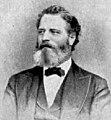
1829 - 1910 Person Name: Dr. W. B. Gilbert Composer of "[The Lord is my Light and my Salvation]" in Sunday-School Book Walter Bond Gilbert DMus United Kingdom 1829-1910. Born at Exeter, Devon, England, he studied music under Alfred Angel, Samuel Wesley and Henry Bishop. He attended New College, Oxford and the University of Toronto, Canada. He was organist in Devon at Topsham in 1847, Bideford in 1849, Kent at Tonbridge in 1854, Old Colliegiate Church, Maidstone in 1859, Lee in 1866, Boston, Lincolnshirein 1868, and Trinity Chapel in New York City in 1869-1897. He taught music at Tonbridge School, helped found the College of Organists, edited the America Episcopal Hymnal, and wrote a number of monographs, including “Antiquities of Maidstone”. He continued to write church music, producing services, oratorios (including “The Restoration of Israel and St. John, 1857), organ works, and anthems. He died at Headington, Oxford, England.
John Perry
Walter Bond Gilbert
Richard Woodward
1743 - 1777 Person Name: Dr. Woodward Composer of "[The Lord is my Light and my Salvation]" in Sunday-School Book Woodward, Richard, jr; b. 1743?; d. Dublin, 22 Nov. 1777; Anglo-Irish organist and composer
LOC Name Authority File
Richard Woodward
Thomas Attwood
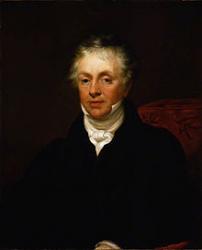
1765 - 1838 Person Name: T. Attwood Composer of "[The Lord is my Light and my Salvation]" in Sunday-School Book Thomas Attwood, born 1767; organist and composer; wrote many operas and other works; died March 24, 1838.
A Dictionary of Musical Information by John W. Moore, Boston: Oliver, Ditson & Company, 1876
Thomas Attwood
Richard Goodson
1655 - 1718 Person Name: R. Goodson, 1655 - 1718 Composer of "[The Lord is my light and my salvation]" in The Hymnary of the United Church of Canada
Richard Goodson
Richard Langdon
1730 - 1803 Person Name: Langdon Composer of "[The Lord is my Light and my Salvation]" in Sunday-School Book
Richard Langdon
Benjamin C. Blodgett
1838 - 1925 Person Name: B. C. Blodgett Composer of "[The Lord is my light and my salvation whom shall I fear]" in Hymns of Worship and Service
Benjamin C. Blodgett
E. Edwards
Composer of "[The Lord is my light and my salvation]" in The Hymnal of the Protestant Episcopal Church in the United States of America 1940
E. Edwards
E. Higgins
1669 - 1769 Person Name: Higgins Composer of "[The Lord is my light and my salvation]" in Songs for the Lord's House
E. Higgins
Clarence Whiteman
Composer (Anglican Chant) of "[The Lord is my light and my salvation]" in Lift Every Voice and Sing II
Clarence Whiteman


 My Starred Hymns
My Starred Hymns


